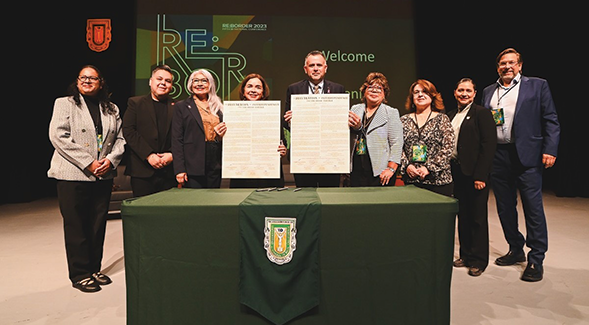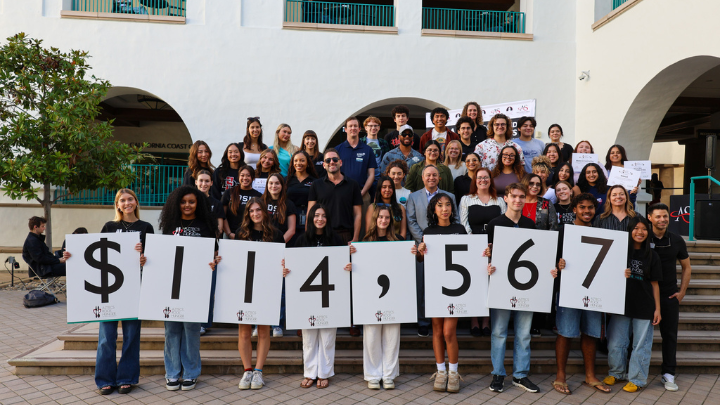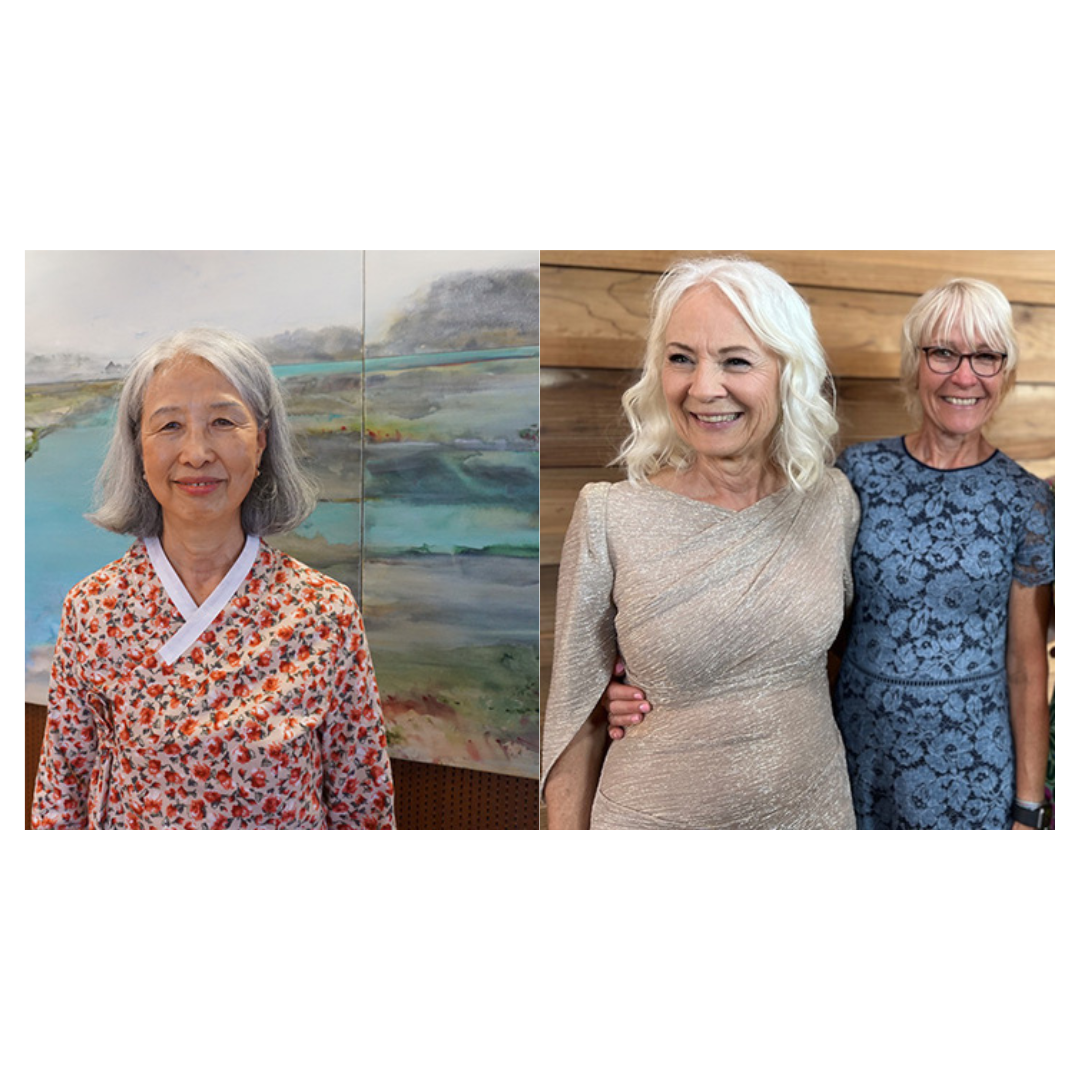SDSU's Re:Border 2023 Conference Spotlights Chance to Design Better Border
Binational innovations embody the spirit of interdependence to build a stronger CaliBaja Region

The challenges at the San Diego-Tijuana border — migration, security, pollution — tend to make headlines. Potential solutions usually don’t.
The fifth annual Re:Border 2023 conference hosted by Universidad Autónoma de Baja California (UABC) in Tijuana, wrapped up Oct. 25, shining the spotlight on binational projects and collaborations making the CaliBaja border region better.
The Re:Border 2023 conference, titled “Designing Oportunidades," brought together about 400 people, including students, faculty, policy experts, artists and community leaders involved in border issues.
“You will hear much today about ‘interdependence’ as we talk about California and Baja and our transborder region,” SDSU President Adela de la Torre said in opening the event. “We are really talking about synergy, the ability to be more than the sum of our respective parts, to create mutual benefit and support each other in the pursuit of progress and innovation.”
The region faces big challenges around migration, the economy and environment, to name a few, said Luis Enrique Palafox Maestre, president of UABC.
“But with great creativity, collaboration and a shared vision, actions can be generated that provide specific responses to these challenges,” he said.
Earlier this year, San Diego and Tijuana earned the World Design Capital 2024 designation, which is akin to the Olympics of urban planning and design.
It is the first time that two cross-border cities have received the title from the World Design Organization, a non-profit that every two years recognizes cities for their effective use of design to drive economic, social, cultural, and environmental development. Previous World Design Capital cities include Seoul, Taipei, Helsinki and Cape Town.
“Design has become a fundamental tool for making cities more attractive, competitive, efficient, and sustainable,” said Laura E. Araujo, director of programs for World Design Capital San Diego-Tijuana 2024. “We have a once-in-a-lifetime, year-long opportunity to showcase our unique creative talent to the world.”
Here are five noteworthy highlights from the conference:
Declaration of Interdependence
The conference kicked off with a “Declaration of Interdependence for San Diego Tijuana.” The statement frames the notion that San Diego and Tijuana are better together than separate, and the region’s sustainability depends on collaboration.
Presidents and representatives from SDSU, UABC and other partner universities, including Colegio de la Frontera (COLEF) and Southwestern College, attended the signing ceremony. All attendees and community members are encouraged to read the Declaration and participate by digitally adding their names throughout 2024 and at events commemorating the region's designation as a World Design Capital.
Spotlight on Water Scarcity
Tijuana relies on the Colorado River for much of its water and faces a problem with scarcity, said Gabriela Munoz-Melendez, a research professor at El Colegio de la Frontera Norte. Re-using wastewater is among the possible solutions but is hindered by a lack of investment.
During the panel discussion, a member of the audience called the chronic sewage flows from Tijuana into coastal San Diego County “embarrassing” and suggested pressuring governments in Mexico to do more about it.
This week, the Biden Administration requested $310 million from Congress to repair and expand the South Bay International Wastewater Treatment Plant in San Ysidro, with the aim of mitigating the sewage problem from Tijuana. SDSU has a group of more than a dozen faculty, called Blue Gold, researching water scarcity, erosion, pollution, and other cross-border water issues, said SDSU Geology Professor Trent Biggs.
“There’s a lot of investment (from both governments) to help resolve these issues,” said Biggs. “We are committed to documenting the success of those investments.”
Binational Flash Pitch Think Tank
This year’s Re:Border introduced a Shark Tank-like quick pitch research competition sponsored by SDSU’s Division of Research and Innovation. Thirteen research teams presented projects to a panel of judges in hopes of winning one of two $5,000 mini-grants.
Two binational teams received funding. The STEM prize went to an anammox anaerobic baffled reactor pilot study for nitrogen removal from wastewater. The project is co-led by SDSU Engineering Professor Natalie Mladenov and Tecnológico Nacional de México, Instituto Tecnológico de Tijuana Professor of Biochemical Engineering Mercedes Teresita Oropeza. The project will also include students from SDSU and Tijuana Tech at San Diego State’s Water Innovation and Reuse Lab.
While still in the research phase, the low-cost anammox reactors have the potential to be incorporated into decentralized wastewater treatment systems to reduce nutrient pollution in surface waters in Tijuana and worldwide.
The Education/Social Science/Arts $5,000 mini-grant went to a team that includes binational doctoral students and lead researchers Melissa NavarroMartell, SDSU professor, and Yara Amparo Lopez Lopez, state coordinador with La Secretaria de Educacion en Baja California and for a project aimed at preparing educators to teach STEM to “the students we share'' within the Baja and California region.
Navarro Martell’s research focuses on bilingual science education. She is collaborating with Reyna Roa Rivera at UABC, as well as the Binational Migrant Education Program in Baja California. Student researchers also are involved. The project aims to develop a STEM-focused manual targeting educators in the U.S. and Mexico so they have better strategies for teaching transnational migrant students.
Social Innovation through Art
When SDSU Graphic Design Professor Arzu Ozkal learned Re:Border was titled “Designing Oportunidades,” she pondered what opportunities could be designed for art students.
After consulting with colleagues at UABC, the group came up with an experiment in collaboration, where SDSU students would be paired with UABC students to create artworks responding to the themes and conversations that were being discussed at the conference.
Six students from San Diego State and 13 from UASB participated. “We teamed them up,” said Ozkal. “They didn’t know each other. The students are from different backgrounds. These moments really surprise you and open your mind to possibilities.”
Organizers want the relationships to continue, so they offered a $1,000 prize to one team to finish their piece and display it at the SDSU campus, possibly in the spring.
The winners are Gabrielle Berens, a Master of Fine Arts student at SDSU, and Valery Anette Limas Alvarez and Oliva Carolina Ubiña Reynoso, both plastic arts majors at UABC. They created a sculpture that resembled a thin pyramid. A wire hung from the center, covered with multi-colored cloth and two-strand braiding to symbolize coming together. The ascending cloth-covered wire symbolized the transition from chaos toward hope in a re-imagined future on the border, said Berens.



